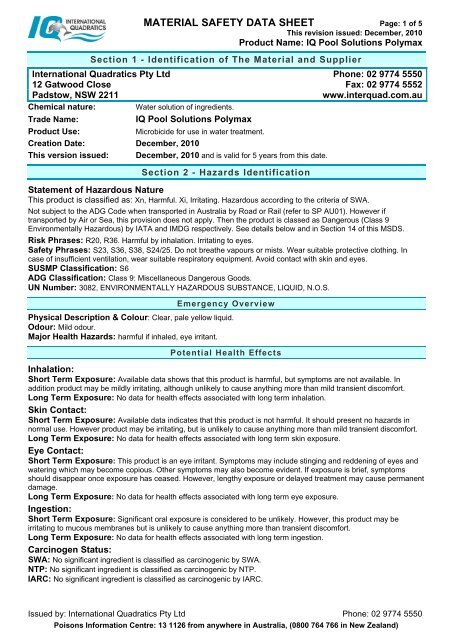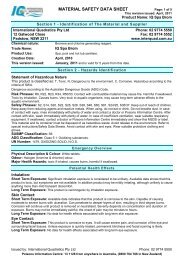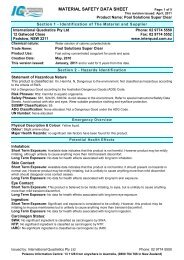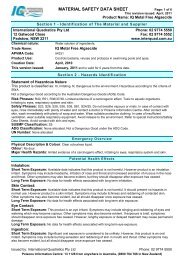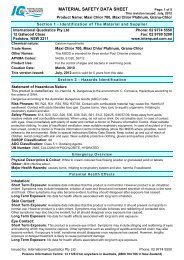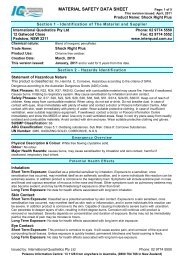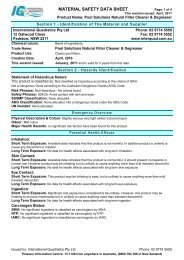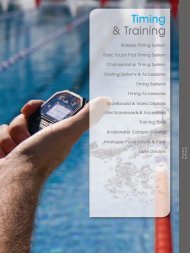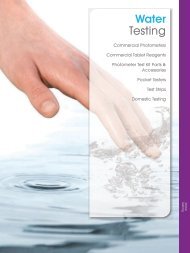IQ Polymax Algaecide - Pierce Pool Supplies
IQ Polymax Algaecide - Pierce Pool Supplies
IQ Polymax Algaecide - Pierce Pool Supplies
Create successful ePaper yourself
Turn your PDF publications into a flip-book with our unique Google optimized e-Paper software.
MATERIAL SAFETY DATA SHEET Page: 1 of 5<br />
This revision issued: December, 2010<br />
Product Name: <strong>IQ</strong> <strong>Pool</strong> Solutions <strong>Polymax</strong><br />
Section 1 - Identification of The Material and Supplier<br />
International Quadratics Pty Ltd Phone: 02 9774 5550<br />
12 Gatwood Close Fax: 02 9774 5552<br />
Padstow, NSW 2211<br />
www.interquad.com.au<br />
Chemical nature:<br />
Water solution of ingredients.<br />
Trade Name:<br />
<strong>IQ</strong> <strong>Pool</strong> Solutions <strong>Polymax</strong><br />
Product Use:<br />
Microbicide for use in water treatment.<br />
Creation Date: December, 2010<br />
This version issued: December, 2010 and is valid for 5 years from this date.<br />
Section 2 - Hazards Identification<br />
Statement of Hazardous Nature<br />
This product is classified as: Xn, Harmful. Xi, Irritating. Hazardous according to the criteria of SWA.<br />
Not subject to the ADG Code when transported in Australia by Road or Rail (refer to SP AU01). However if<br />
transported by Air or Sea, this provision does not apply. Then the product is classed as Dangerous (Class 9<br />
Environmentally Hazardous) by IATA and IMDG respectively. See details below and in Section 14 of this MSDS.<br />
Risk Phrases: R20, R36. Harmful by inhalation. Irritating to eyes.<br />
Safety Phrases: S23, S36, S38, S24/25. Do not breathe vapours or mists. Wear suitable protective clothing. In<br />
case of insufficient ventilation, wear suitable respiratory equipment. Avoid contact with skin and eyes.<br />
SUSMP Classification: S6<br />
ADG Classification: Class 9: Miscellaneous Dangerous Goods.<br />
UN Number: 3082, ENVIRONMENTALLY HAZARDOUS SUBSTANCE, L<strong>IQ</strong>UID, N.O.S.<br />
Emergency Overview<br />
Physical Description & Colour: Clear, pale yellow liquid.<br />
Odour: Mild odour.<br />
Major Health Hazards: harmful if inhaled, eye irritant.<br />
Potential Health Effects<br />
Inhalation:<br />
Short Term Exposure: Available data shows that this product is harmful, but symptoms are not available. In<br />
addition product may be mildly irritating, although unlikely to cause anything more than mild transient discomfort.<br />
Long Term Exposure: No data for health effects associated with long term inhalation.<br />
Skin Contact:<br />
Short Term Exposure: Available data indicates that this product is not harmful. It should present no hazards in<br />
normal use. However product may be irritating, but is unlikely to cause anything more than mild transient discomfort.<br />
Long Term Exposure: No data for health effects associated with long term skin exposure.<br />
Eye Contact:<br />
Short Term Exposure: This product is an eye irritant. Symptoms may include stinging and reddening of eyes and<br />
watering which may become copious. Other symptoms may also become evident. If exposure is brief, symptoms<br />
should disappear once exposure has ceased. However, lengthy exposure or delayed treatment may cause permanent<br />
damage.<br />
Long Term Exposure: No data for health effects associated with long term eye exposure.<br />
Ingestion:<br />
Short Term Exposure: Significant oral exposure is considered to be unlikely. However, this product may be<br />
irritating to mucous membranes but is unlikely to cause anything more than transient discomfort.<br />
Long Term Exposure: No data for health effects associated with long term ingestion.<br />
Carcinogen Status:<br />
SWA: No significant ingredient is classified as carcinogenic by SWA.<br />
NTP: No significant ingredient is classified as carcinogenic by NTP.<br />
IARC: No significant ingredient is classified as carcinogenic by IARC.<br />
Issued by: International Quadratics Pty Ltd Phone: 02 9774 5550<br />
Poisons Information Centre: 13 1126 from anywhere in Australia, (0800 764 766 in New Zealand)
MATERIAL SAFETY DATA SHEET Page: 2 of 5<br />
This revision issued: December, 2010<br />
Product Name: <strong>IQ</strong> <strong>Pool</strong> Solutions <strong>Polymax</strong><br />
Section 3 - Composition/Information on Ingredients<br />
Ingredients CAS No Conc,% TWA (mg/m 3 ) STEL (mg/m 3 )<br />
Poly[oxyethylene(dimethylimino)ethylene(dimethylimino)ethylene<br />
31075-24-8 685g/L not set not set<br />
Other non hazardous ingredients secret to 100 not set not set<br />
This is a commercial product whose exact ratio of components may vary slightly. Minor quantities of other non<br />
hazardous ingredients are also possible.<br />
The SWA TWA exposure value is the average airborne concentration of a particular substance when calculated over a normal 8 hour working day<br />
for a 5 day working week. The STEL (Short Term Exposure Limit) is an exposure value that may be equalled (but should not be exceeded) for no<br />
longer than 15 minutes and should not be repeated more than 4 times per day. There should be at least 60 minutes between successive exposures<br />
at the STEL. The term "peak "is used when the TWA limit, because of the rapid action of the substance, should never be exceeded, even briefly.<br />
Section 4 - First Aid Measures<br />
General Information:<br />
You should call The Poisons Information Centre if you feel that you may have been poisoned, burned or irritated by<br />
this product. The number is 13 1126 from anywhere in Australia (0800 764 766 in New Zealand) and is available at all<br />
times. Have this MSDS with you when you call.<br />
Inhalation: If symptoms of poisoning become evident, contact a Poisons Information Centre, or call a doctor at<br />
once. Remove source of contamination or move victim to fresh air. If breathing is difficult, oxygen may be beneficial if<br />
administered by trained personnel, preferably on a doctor's advice. DO NOT allow victim to move about<br />
unnecessarily. Symptoms of pulmonary oedema can be delayed up to 48 hours after exposure.<br />
Skin Contact: Wash gently and thoroughly with water (use non-abrasive soap if necessary) for 5 minutes or until<br />
chemical is removed.<br />
Eye Contact: Immediately flush the contaminated eye(s) with lukewarm, gently flowing water for 20 minutes or until<br />
the product is removed, while holding the eyelid(s) open. Take care not to rinse contaminated water into the<br />
unaffected eye or onto the face. Obtain medical attention immediately. Take special care if exposed person is wearing<br />
contact lenses.<br />
Ingestion: If product is swallowed or gets in mouth, do NOT induce vomiting; wash mouth with water and give some<br />
water to drink. If symptoms develop, or if in doubt contact a Poisons Information Centre or a doctor.<br />
Section 5 - Fire Fighting Measures<br />
Fire and Explosion Hazards: This product is classified as a C1 combustible product. There is little risk of an<br />
explosion from this product if commercial quantities are involved in a fire.<br />
This product is likely to decompose only after heating to dryness, followed by further strong heating.<br />
Fire decomposition products from this product may be toxic if inhaled. Take appropriate protective measures.<br />
Extinguishing Media: Suitable extinguishing media are carbon dioxide, dry chemical, foam, water fog. Alcohol<br />
resistant foam is the preferred firefighting medium but, if it is not available, normal foam can be used. Try to contain<br />
spills, minimise spillage entering drains or water courses.<br />
Fire Fighting: If a significant quantity of this product is involved in a fire, call the fire brigade. There is little danger of<br />
a violent reaction or explosion if significant quantities of this product are involved in a fire. Recommended personal<br />
protective equipment is full fire kit and breathing apparatus.<br />
Flash point:<br />
>100°C, TCC<br />
Upper Flammability Limit: No data<br />
Lower Flammability Limit: No data<br />
Autoignition temperature: No data<br />
Flammability Class: C1<br />
Section 6 - Accidental Release Measures<br />
Accidental release: In the event of a major spill, prevent spillage from entering drains or water courses. Wear full<br />
protective clothing including eye/face protection. All skin areas should be covered. See below under Personal<br />
Protection regarding Australian Standards relating to personal protective equipment. Suitable materials for protective<br />
clothing include rubber, PVC. Eye/face protective equipment should comprise as a minimum, protective goggles. If<br />
there is a significant chance that vapours or mists are likely to build up in the cleanup area, we recommend that you<br />
use a respirator. Usually, no respirator is necessary when using this product. However, if you have any doubts consult<br />
the Australian Standard mentioned below (section 8). Otherwise, not normally necessary.<br />
Issued by: International Quadratics Pty Ltd Phone: 02 9774 5550<br />
Poisons Information Centre: 13 1126 from anywhere in Australia, (0800 764 766 in New Zealand)
MATERIAL SAFETY DATA SHEET Page: 3 of 5<br />
This revision issued: December, 2010<br />
Product Name: <strong>IQ</strong> <strong>Pool</strong> Solutions <strong>Polymax</strong><br />
Stop leak if safe to do so, and contain spill. Absorb onto sand, vermiculite or other suitable absorbent material. If spill<br />
is too large or if absorbent material is not available, try to create a dike to stop material spreading or going into drains<br />
or waterways. Because of the environmentally hazardous nature of this product, special care should be taken to<br />
restrict release to waterways or drains. Sweep up and shovel or collect recoverable product into labelled containers<br />
for recycling or salvage, and dispose of promptly. Recycle containers wherever possible after careful cleaning. After<br />
spills, wash area preventing runoff from entering drains. If a significant quantity of material enters drains, advise<br />
emergency services. This material may be suitable for approved landfill. Ensure legality of disposal by consulting<br />
regulations prior to disposal. Thoroughly launder protective clothing before storage or re-use. Advise laundry of nature<br />
of contamination when sending contaminated clothing to laundry.<br />
Section 7 - Handling and Storage<br />
Handling: Keep exposure to this product to a minimum, and minimise the quantities kept in work areas. Check<br />
Section 8 of this MSDS for details of personal protective measures, and make sure that those measures are followed.<br />
The measures detailed below under "Storage" should be followed during handling in order to minimise risks to<br />
persons using the product in the workplace. Also, avoid contact or contamination of product with incompatible<br />
materials listed in Section 10.<br />
Storage: This product is a Scheduled Poison. Observe all relevant regulations regarding sale, transport and storage<br />
of this schedule of poison. Check packaging - there may be further storage instructions on the label.<br />
Section 8 - Exposure Controls and Personal Protection<br />
The following Australian Standards will provide general advice regarding safety clothing and equipment:<br />
Respiratory equipment: AS/NZS 1715, Protective Gloves: AS 2161, Occupational Protective Clothing: AS/NZS 4501<br />
set 2008, Industrial Eye Protection: AS1336 and AS/NZS 1337, Occupational Protective Footwear: AS/NZS2210.<br />
SWA Exposure Limits TWA (mg/m 3 ) STEL (mg/m 3 )<br />
Exposure limits have not been established by SWA for any of the significant ingredients in this product.<br />
No special equipment is usually needed when occasionally handling small quantities. The following instructions are<br />
for bulk handling or where regular exposure in an occupational setting occurs without proper containment systems.<br />
Ventilation: This product should only be used in a well ventilated area. If natural ventilation is inadequate, use of a<br />
fan is suggested.<br />
Eye Protection: Protective glasses or goggles should be worn when this product is being used. Failure to protect<br />
your eyes may cause them harm. Emergency eye wash facilities are also recommended in an area close to where<br />
this product is being used.<br />
Skin Protection: You should avoid contact even with mild skin irritants. Therefore you should wear suitable<br />
impervious elbow-length gloves and facial protection when handling this product. See below for suitable material<br />
types.<br />
Protective Material Types: We suggest that protective clothing be made from the following materials: rubber,<br />
PVC.<br />
Respirator: Usually, no respirator is necessary when using this product. However, if you have any doubts consult<br />
the Australian Standard mentioned above. Otherwise, not normally necessary.<br />
Eyebaths or eyewash stations and safety deluge showers should be provided near to where this product is being<br />
used.<br />
Physical Description & colour:<br />
Odour:<br />
Boiling Point:<br />
Freezing/Melting Point:<br />
Volatiles:<br />
Vapour Pressure:<br />
Vapour Density:<br />
Specific Gravity:<br />
Water Solubility:<br />
pH:<br />
Volatility:<br />
Odour Threshold:<br />
Evaporation Rate:<br />
Coeff Oil/water Distribution:<br />
Autoignition temp:<br />
Section 9 - Physical and Chemical Properties:<br />
Clear, pale yellow liquid.<br />
Mild odour.<br />
Above 100°C at 100kPa.<br />
Below -10°C.<br />
Water component.<br />
2.37 kPa at 20°C (water vapour pressure).<br />
No data.<br />
1.10 approx<br />
Completely soluble in water.<br />
6.0-8.0 (as supplied)<br />
No data.<br />
No data.<br />
No data.<br />
No data<br />
No data<br />
Issued by: International Quadratics Pty Ltd Phone: 02 9774 5550<br />
Poisons Information Centre: 13 1126 from anywhere in Australia, (0800 764 766 in New Zealand)
MATERIAL SAFETY DATA SHEET Page: 4 of 5<br />
This revision issued: December, 2010<br />
Product Name: <strong>IQ</strong> <strong>Pool</strong> Solutions <strong>Polymax</strong><br />
Section 10 - Stability and Reactivity<br />
Reactivity: This product is unlikely to react or decompose under normal storage conditions. However, if you have<br />
any doubts, contact the supplier for advice on shelf life properties.<br />
Conditions to Avoid: This product should be kept in a cool place, preferably below 30°C. Keep containers tightly<br />
closed.<br />
Incompatibilities: anionic surfactants and polymers.<br />
Fire Decomposition: This product is likely to decompose only after heating to dryness, followed by further strong<br />
heating. Combustion forms carbon dioxide, and if incomplete, carbon monoxide. Water is also formed. May form<br />
nitrogen and its compounds, and under some circumstances, oxides of nitrogen. Occasionally hydrogen cyanide gas<br />
in reducing atmospheres. Carbon monoxide poisoning produces headache, weakness, nausea, dizziness, confusion,<br />
dimness of vision, disturbance of judgment, and unconsciousness followed by coma and death.<br />
Polymerisation: This product will not undergo polymerisation reactions.<br />
Section 11 - Toxicological Information<br />
Local Effects:<br />
Target Organs:<br />
There is no data to hand indicating any particular target organs.<br />
Classification of Hazardous Ingredients<br />
Ingredient<br />
Risk Phrases<br />
No ingredient mentioned in the HSIS Database is present in this product at hazardous concentrations.<br />
LD 50 Oral, Rat 1951 mg/kg (male), 2587mg/kg (female)<br />
LD 50 Dermal, Rabbit = >2000mg/kg<br />
LC 50 Inhalation, Rat = 2.9mg/L/4hr<br />
Section 12 - Ecological Information<br />
This product is very toxic to aquatic organisms. Insufficient data to be sure of biodegradation status.<br />
Fish: LC 50 rainbow trout (Oncorhynchus mykiss): 0.047mg/L<br />
Daphnia: EC 50 0.37mg/L<br />
Section 13 - Disposal Considerations<br />
Disposal: This product may be recycled if unused, or if it has not been contaminated so as to make it unsuitable for<br />
its intended use. If it has been contaminated, it may be possible to separate the contamination in some way. Only if<br />
neither of these options is suitable, consider landfill.<br />
Section 14 - Transport Information<br />
Not subject to the ADG Code when transported by Road or Rail in Australia, but classed as<br />
Dangerous by IATA and IMDG when carried by Air or Sea transport (see details below).<br />
ADG Code: 3082, ENVIRONMENTALLY HAZARDOUS SUBSTANCE, L<strong>IQ</strong>UID, N.O.S.<br />
Hazchem Code: •3Z<br />
Special Provisions: 179, 274, AU01<br />
Limited quantities: ADG 7 specifies a Limited Quantity value of 5 L for this class of product.<br />
Dangerous Goods Class: Class 9: Miscellaneous Dangerous Goods.<br />
Packaging Group: III<br />
Packaging Method: P001, IBC03, LP01<br />
Class 9 Miscellaneous Dangerous Goods shall not be loaded in the same vehicle or packed in the same freight<br />
container with Dangerous Goods of Class 1 (Explosives).<br />
Section 15 - Regulatory Information<br />
AICS: All of the significant ingredients in this formulation are compliant with NICNAS regulations.<br />
The following ingredient: Poly[oxyethylene(dimethylimino)ethylene(dimethylimino)ethylene, (a quaternary ammonium<br />
compound) is mentioned in the SUSMP.<br />
Issued by: International Quadratics Pty Ltd Phone: 02 9774 5550<br />
Poisons Information Centre: 13 1126 from anywhere in Australia, (0800 764 766 in New Zealand)
Acronyms:<br />
ADG Code<br />
AICS<br />
SWA<br />
CAS number<br />
Hazchem Code<br />
IARC<br />
NOS<br />
NTP<br />
R-Phrase<br />
SUSMP<br />
UN Number<br />
MATERIAL SAFETY DATA SHEET Page: 5 of 5<br />
This revision issued: December, 2010<br />
Product Name: <strong>IQ</strong> <strong>Pool</strong> Solutions <strong>Polymax</strong><br />
Section 16 - Other Information<br />
This MSDS contains only safety-related information. For other data see product literature.<br />
Australian Code for the Transport of Dangerous Goods by Road and Rail (7 th edition)<br />
Australian Inventory of Chemical Substances<br />
Safe Work Australia, formerly ASCC and NOHSC<br />
Chemical Abstracts Service Registry Number<br />
Emergency action code of numbers and letters that provide information to emergency<br />
services especially firefighters<br />
International Agency for Research on Cancer<br />
Not otherwise specified<br />
National Toxicology Program (USA)<br />
Risk Phrase<br />
Standard for the Uniform Scheduling of Medicines & Poisons<br />
United Nations Number<br />
THIS MSDS SUMMARISES OUR BEST KNOWLEDGE OF THE HEALTH AND SAFETY HAZARD INFORMATION OF THE PRODUCT AND<br />
HOW TO SAFELY HANDLE AND USE THE PRODUCT IN THE WORKPLACE. EACH USER MUST REVIEW THIS MSDS IN THE CONTEXT OF<br />
HOW THE PRODUCT WILL BE HANDLED AND USED IN THE WORKPLACE.<br />
IF CLARIFICATION OR FURTHER INFORMATION IS NEEDED TO ENSURE THAT AN APPROPRIATE RISK ASSESSMENT CAN BE MADE,<br />
THE USER SHOULD CONTACT THIS COMPANY SO WE CAN ATTEMPT TO OBTAIN ADDITIONAL INFORMATION FROM OUR SUPPLIERS<br />
OUR RESPONSIBILITY FOR PRODUCTS SOLD IS SUBJECT TO OUR STANDARD TERMS AND CONDITIONS, A COPY OF WHICH IS SENT<br />
TO OUR CUSTOMERS AND IS ALSO AVAILABLE ON REQUEST.<br />
Please read all labels carefully before using product.<br />
This MSDS is prepared in accord with the SWA document “National Code of Practice for the Preparation of<br />
Material Safety Data Sheets” 2nd Edition [NOHSC:2011(2003)]<br />
Copyright © Kilford & Kilford Pty Ltd, December, 2010.<br />
http://www.kilford.com.au/ Phone (02)9251 4532<br />
Issued by: International Quadratics Pty Ltd Phone: 02 9774 5550<br />
Poisons Information Centre: 13 1126 from anywhere in Australia, (0800 764 766 in New Zealand)


